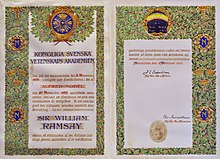Quick Facts

Biography
Sir William Ramsay KCB, FRS, FRSE (2 October 1852 – 23 July 1916) was a Scottish chemist who discovered the noble gases and received the Nobel Prize in Chemistry in 1904 "in recognition of his services in the discovery of the inert gaseous elements in air" (along with his collaborator, Lord Rayleigh, who received the Nobel Prize in Physics that same year for their discovery of argon). After the two men identified argon, Ramsay investigated other atmospheric gases. His work in isolating argon, helium, neon, krypton and xenon led to the development of a new section of the periodic table.
Early years
Ramsay was born in Glasgow on 2 October 1852, the son of civil engineer William Ramsay and Catherine, née Robertson. He was a nephew of the geologist Sir Andrew Ramsay.
He attended the Glasgow Academy and then continued his education at the University of Glasgow with Thomas Anderson and then went to study in Germany at the University of Tübingen with Wilhelm Rudolph Fittig where his doctoral thesis was entitled Investigations in the Toluic and Nitrotoluic Acids.
Ramsay went back to Glasgow as Anderson's assistant at the Anderson College. He was appointed as Professor of Chemistry at the University College of Bristol in 1879 and married Margaret Buchanan in 1881. In the same year he became the Principal of University College, Bristol, and somehow managed to combine that with active research both in organic chemistry and on gases.
Career


In 1887 he succeeded Alexander Williamson as the chair of Chemistry at University College London (UCL). It was here at UCL that his most celebrated discoveries were made. As early as 1885–1890 he published several notable papers on the oxides of nitrogen, developing the skills that he needed for his subsequent work.
On the evening of 19 April 1894 Ramsay attended a lecture given by Lord Rayleigh. Rayleigh had noticed a discrepancy between the density of nitrogen made by chemical synthesis and nitrogen isolated from the air by removal of the other known components. After a short conversation he and Ramsay decided to follow this up. By August, Ramsay could write to Rayleigh to announce that he had isolated a heavy component of air, previously unknown, which did not appear to have any obvious chemical reactivity. He named the gas, which is inert, with the Greek word for "lazy", "argon". In the following years, working with Morris Travers, he discovered neon, krypton, and xenon. He also isolated helium which had been observed in the spectrum of the sun but had not been found on earth. In 1910 he also made and characterized radon.
In 1904 Ramsay received the Nobel Prize in Chemistry. Ramsay's high standing in scientific circles led to him being an adviser in the setting up the Indian Institute of Science. He suggested Bangalore as the most appropriate location for the institute.
Ramsay’s high standing in scientific circles led to his unfortunate endorsement in 1905 of the Industrial and Engineering Trust Ltd., a corporation with a supposed secret process to extract gold from seawater. The corporation bought property along the English coast to implement the gold-from-seawater process, but the company quickly faded from public view, and never produced any gold.
Ramsay was the president of the British Association in 1911–1912.
Personal life
Ramsay was married to Margaret Johnstone Marshall (née Buchanan, daughter of George Stevenson Buchanan) and had a daughter, Catherine Elizabeth (Elska) and a son, William George, who died at 40.
Ramsay lived in Hazlemere, Buckinghamshire until his death. He died in High Wycombe, Buckinghamshire, on 23 July 1916 from nasal cancer at the age of 63 and was buried in Hazlemere Parish church.
A blue plaque at number 12 Arundel Gardens, Notting Hill, commemorates his life and work.
The Sir William Ramsay School in Hazlemere, and the Ramsay grease, are named after him.
